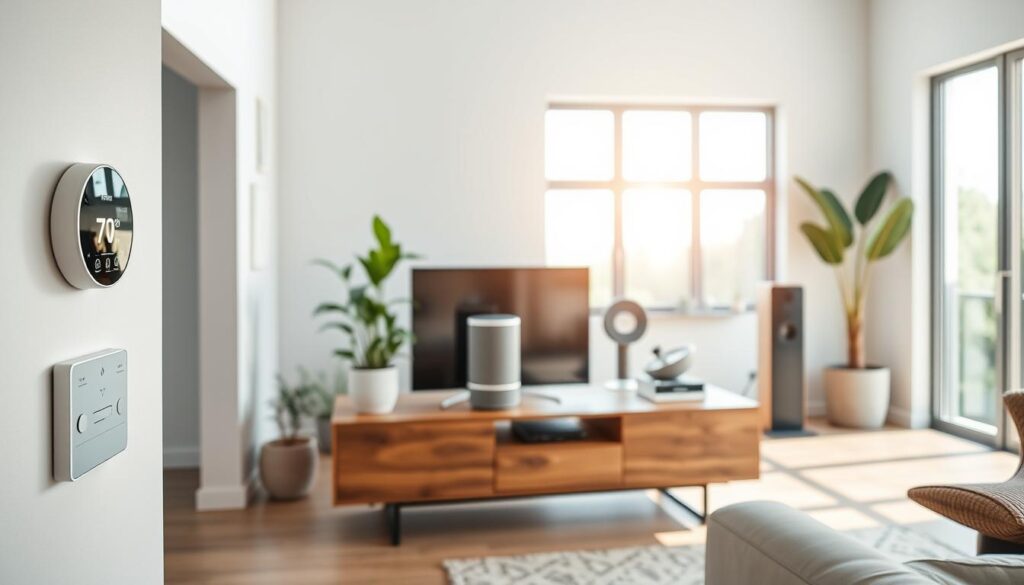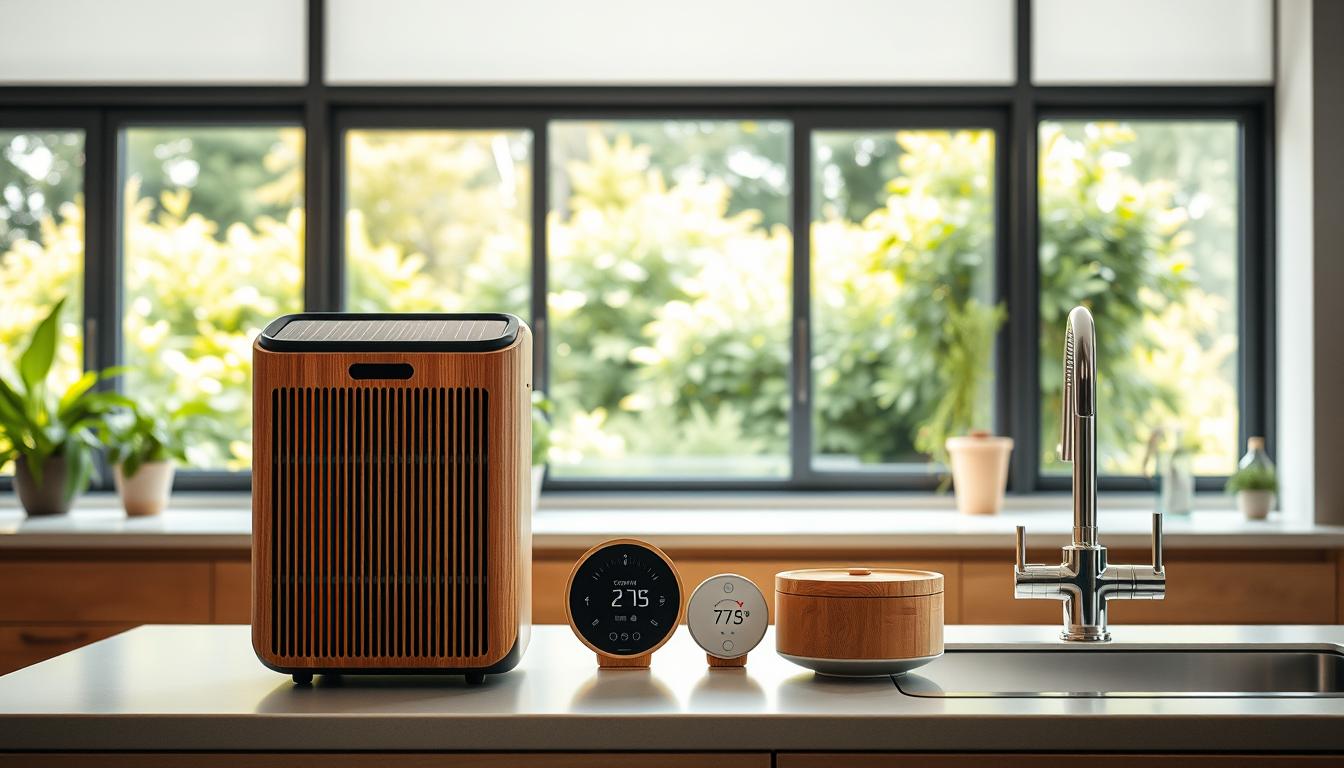Transform your home into a space that’s both beautiful and sustainable. Eco-friendly gadgets for home blend modern design with environmental responsibility. From smart thermostats to solar-powered chargers, these devices cut energy use while fitting seamlessly into everyday life. Imagine LED lights that last years or Wi-Fi connected plugs that save power automatically. These innovations aren’t just trends—they’re practical steps toward a greener lifestyle.
Key Takeaways
- Eco-friendly gadgets for home merge style with sustainability.
- They reduce energy waste and lower utility bills.
- Options like smart plugs and solar chargers fit any room.
- Modern designs ensure they match contemporary home aesthetics.
- Choosing these gadgets supports long-term environmental goals.
Introduction to Sustainable Home Technologies
Home life is evolving with gadgets that balance style and planet care. Sustainable home technologies focus on devices designed to reduce environmental harm. These innovations prioritize renewable energy, recyclable materials, and long-term efficiency.
Defining Eco-friendly Gadgets
Eco-friendly gadgets avoid harmful materials like plastics and toxic chemicals. They often use solar power, LED lighting, or smart sensors to cut energy use. For example, a solar-powered charger or a Wi-Fi connected thermostat that learns usage patterns qualifies.
| Traditional Tech | Sustainable Options |
|---|---|
| Single-use batteries | Rechargeable battery systems |
| Incandescent bulbs | Energy Star-certified LEDs |
Why Sustainable Home Technologies Matter
- Cut electricity bills by 30% with energy-efficient models
- Reduce landfill waste through durable, repairable designs
- Lower carbon emissions by relying on renewable energy
“Smart appliances aren’t just gadgets—they’re tools for building a greener future.” — Green Tech Innovations Report 2023
Every choice from lighting to heating impacts the planet. By adopting sustainable home technologies, households can protect resources without sacrificing comfort. These solutions prove eco-conscious living is both practical and accessible.
The Rise of Green Home Devices
Consumers are increasingly prioritizing sustainability, driving a surge in demand for green home devices. Market reports show a 15% annual growth in eco-friendly tech sales, reflecting a global shift toward greener living. These gadgets now blend style with function, making sustainability accessible for every room.
- Environmental awareness: Rising concern over climate change pushes buyers toward energy-efficient options.
- Cost savings: Devices like Nest Learning Thermostats cut utility bills while reducing carbon footprints.
- Tech innovation: Companies like Philips and LG now offer LED lighting and appliances with recycled materials.
Customers also value certifications like Energy Star or Cradle to Cradle, ensuring products meet rigorous eco-standards. For instance, Ecobee’s smart sensors optimize heating systems using AI, proving tech can be both smart and sustainable. Even small appliances, such as compost bins or solar-powered chargers, are gaining traction.
“Sustainable tech isn’t a trend—it’s a necessity. Green home devices are now essential for modern living.” – 2023 Global Sustainability Report
From smart speakers with low-power modes to solar-powered security cameras, these innovations show how green home devices are redefining daily life. As tech evolves, so does the promise of a cleaner, smarter future—one room at a time.
Innovative Eco-conscious Household Products
Modern environmentally friendly home gadgets merge sleek design with sustainability, proving eco-friendly doesn’t mean sacrificing style. From smart thermostats to solar-powered chargers, these products prioritize both planet and personal space.
Cutting-edge Features and Design
Leading brands like Philips and EcoFlow create devices that blend innovation with aesthetics. For instance, the Nest Learning Thermostat uses smart sensors to adjust heating automatically, while the EcoFlow Delta Solar Generator harnesses sunlight for off-grid power. Designers now incorporate recycled materials, like bamboo or reclaimed metal, into appliances, ensuring function never overshadows beauty.
“Sustainability is the new luxury,” says Philips’ design team. “Our products prove eco-tech can be both bold and practical.”
Energy Efficiency in Modern Gadgets
Energy Star-certified devices dominate this space, slashing power use without compromising performance. Below compares traditional vs. eco gadgets:
| Feature | Traditional Gadgets | Environmentally Friendly Home Gadgets |
|---|---|---|
| Energy Use | High consumption | Low, often solar/wind-powered |
| Cost Over Time | Rising utility bills | Long-term savings |
| Certifications | None | Energy Star, LEED |
Devices like the Ecobee Smart Scale track energy use in real time, helping users cut waste. These tools turn sustainability into a seamless part of daily life.
Choosing Environmentally Friendly Home Gadgets for Every Room
Transform your home with eco-conscious household products tailored to each room. From living spaces to kitchens, sustainable choices create a greener lifestyle without sacrificing comfort.

Living Room Must-Haves
Update your living space with smart, eco-friendly upgrades:
- LED lighting: Philips Hue bulbs use 80% less energy than traditional options.
- Energy-saving TVs: Samsung’s 2023 series TVs cut power use by 25% with adaptive brightness.
- Smart thermostats: Nest Learning Thermostat adjusts heat automatically, saving 10-15% on energy bills.
Kitchen and Bath Innovations
| Product | Brand | Key Feature |
|---|---|---|
| Compostable dishware | Ecovative Design | Made from mushroom-based materials, fully biodegradable. |
| Rechargeable food storage | ECOlunchbox | BPA-free containers reduce single-use plastics by 90%. |
| Low-flow fixtures | Delta | Aerators cut water use by 30% without affecting pressure. |
“In the kitchen, every swap counts,” says the EPA’s WaterSense program. “Simple upgrades can slash resource use daily.”
Pairing style with sustainability, these eco-conscious household products prove eco-friendly living is both achievable and stylish.
Smart Home Integration with Sustainable Living Gadgets
Pairing smart home systems with green living electronics creates homes that are both high-tech and planet-friendly. Popular platforms like Apple HomeKit and Google Home now support eco-focused devices, letting users automate energy use seamlessly. For instance, smart thermostats from Nest or ecobee learn routines to cut heating/cooling waste by 10-20%, as reported by the U.S. Department of Energy.
- Smart plugs monitor real-time energy use for appliances
- Water sensors shut off leaks automatically
- LED lighting systems adjust brightness via motion sensors
Systems like Philips Hue connect with solar panels to prioritize renewable energy usage. Users report saving 25% on utility bills by syncing these devices. “My home now adapts without me lifting a finger,” says Sarah, a California homeowner using Samsung’s SmartThings platform. “The app shows exactly how much CO2 I avoid each month.”
Compatibility matters: Check if devices use Zigbee or Z-Wave protocols for smoother integration. Brands like August and Ecobee offer guides to help pair their green living electronics with existing setups. Start small—add a smart recycling bin like Enevo that alerts when trash needs emptying—and expand as needed.
Benefits of Using Eco-friendly Smart Home Devices
Switching to eco-friendly smart home devices isn’t just a trend—it’s a smart move for wallets and the planet. These gadgets blend innovation with sustainability, offering tangible rewards today and tomorrow.

“Smart thermostats alone can cut heating costs by up to 10-15% annually,” says a 2023 Energy Star report. Such savings multiply when paired with other eco-friendly smart home devices.
Cost Efficiency and Savings
- Smart lighting systems like Philips Hue dimmers reduce electricity use by automating brightness based on natural light.
- Water-saving sensors from brands like Rachio cut outdoor water waste by 30%, lowering utility bills.
- Long-term savings: Eco-friendly smart home devices pay for themselves in 2-5 years through energy rebates and reduced consumption.
Positive Environmental Impact
These devices slash carbon footprints by optimizing energy flow. For instance, Nest Learning Thermostats prevent 1,000 pounds of CO₂ yearly per household. Eco-friendly smart home devices also encourage recycling: sensors in smart fridges remind users to compost food scraps, reducing landfill waste.
Investing in these technologies builds a future where homes operate cleaner and smarter. Every upgrade is a step toward greener living without sacrificing comfort.
Exploring Eco-friendly gadgets for home
Emerging tech trends are reshaping how sustainable living gadgets enhance daily life. From smart sensors to solar-powered devices, innovations prioritize both convenience and environmental care. Brands like Nest and Ecobee lead the charge with energy-monitoring systems that adapt to user habits.
Tech Trends Driving Home Innovation
- AI-powered efficiency: Devices like the EcoVessel Bamboo Water Bottle use recycled materials and smart insulation tech.
- Solar integration: Solar-powered phone chargers from brands like Anker reduce grid dependency.
- Smart home compatibility: Philips Hue lighting systems now sync with Alexa for optimized energy use.
User Experiences and Reviews
“My EcoFlow Delta power station cut our grid usage by 40%—it’s life-changing!”
| Gadget | Key Feature | User Rating |
|---|---|---|
| EcoFlow Delta | Portable solar battery | 4.8/5 |
| August Smart Lock | Energy-efficient security | 4.5/5 |
| Philips Hue | LED bulbs with app control | 4.7/5 |
Real-world feedback shows these sustainable living gadgets deliver on promises. With options like reusable coffee makers from OXO or compostable kitchen tools from EcoVessel, every room gains eco-conscious upgrades.
Future Trends in Green Living Electronics
The future of eco-friendly home tech is shaping up to be smarter, sleeker, and more integrated than ever. Innovations like AI-powered energy monitors and self-charging devices are already on the horizon. Imagine gadgets that automatically adjust energy use based on your habits or materials that dissolve harmlessly after their lifespan.
- AI-driven efficiency: Algorithms will optimize home systems in real time, reducing waste without sacrificing comfort.
- Biodegradable components: Companies are testing plant-based plastics and mushroom-based packaging to cut waste.
- Solar breakthroughs: Flexible solar panels could soon power everything from lamps to phone chargers.
Experts predict households will soon generate and share energy through community grids. “The next wave of tech will let homes act as both consumers and contributors to clean energy,” says a 2023 report by the Smart Tech Alliance. Even small devices like smart plugs could become “energy hubs,” connecting appliances to optimize grid usage.
“Sustainability isn’t optional anymore—it’s the new standard for innovation.” – Green Tech Innovators Conference, 2024
Upcoming trends also focus on longevity. Brands are designing gadgets for easy upgrades instead of disposal. For example, modular speakers with replaceable parts aim to reduce e-waste. As these advancements grow, eco-conscious choices will become as intuitive as flipping a light switch.
Conclusion
Making your home greener starts with eco-friendly gadgets that balance style and sustainability. From smart thermostats to solar-powered devices, these tools cut energy use and lower bills while supporting environmental goals. Every upgrade, like Philips Hue lighting or Nest systems, helps build a more efficient, planet-friendly space.
Today’s innovations, such as Tesla solar panels or energy-efficient appliances, prove sustainable living doesn’t require sacrificing comfort. These gadgets integrate seamlessly, turning daily tasks into eco-conscious choices. Brands like LG and Samsung now offer certified energy-saving models, showing how easy it is to join this shift.
Future tech promises even smarter solutions, like AI-driven energy management systems. As demand grows, companies are investing in recyclable materials and zero-waste designs. This momentum means affordable, effective options are here to stay.
Begin with small swaps: replace bulbs with LEDs, track usage with a smart plug, or explore water-saving showerheads. Each change contributes to a bigger impact. By choosing eco-friendly gadgets, you’re not just updating your home—you’re part of a global effort to protect resources for future generations.
FAQ
What are eco-friendly gadgets for home?
Eco-friendly gadgets for home are innovative devices designed with sustainability in mind. They typically use less energy, are made from environmentally friendly materials, and contribute to a greener lifestyle while enhancing everyday comfort and convenience.
How do sustainable home technologies benefit my household?
Sustainable home technologies benefit households by reducing energy consumption and water usage, which can lead to lower utility bills. They also encourage environmentally friendly habits, contributing to a healthier planet and sustainable living.
Can green home devices be stylish as well as functional?
Absolutely! Many green home devices boast modern designs and aesthetic appeal, proving that you can enjoy both style and sustainability. From sleek smart thermostats to elegant LED lighting, sustainable tech can enhance the beauty of your home while being environmentally conscious.
What are some examples of environmentally friendly home gadgets?
Some popular environmentally friendly home gadgets include smart thermostats like the Nest Learning Thermostat, energy-efficient appliances, solar chargers, and water-saving showerheads. These devices are designed to minimize environmental impact while improving overall functionality.
How can I incorporate eco-conscious household products into my home?
Incorporating eco-conscious household products is easy! Start by replacing conventional gadgets with energy-efficient options, investing in sustainable cleaning products, and choosing items made from recycled or biodegradable materials. Look for certifications like Energy Star when selecting appliances.
What should I look for when choosing green living electronics?
When selecting green living electronics, prioritize energy efficiency ratings, material sustainability, and product longevity. Researching user reviews and testimonials can also guide you in making informed decisions that align with your eco-conscious values.
Are eco-friendly smart home devices worth the investment?
Yes, eco-friendly smart home devices are generally worth the investment. They often lead to long-term savings on energy bills and provide added convenience through automation and control of home systems, all while benefiting the environment.
How do sustainable living gadgets enhance my daily routine?
Sustainable living gadgets can streamline daily tasks, enhance energy management, and promote healthier habits. For example, smart irrigation systems can optimize water usage for gardening, and energy monitors can help you track and reduce your consumption effectively.
What are the latest tech trends driving home innovation?
Some of the latest tech trends driving home innovation include the rise of smart home integration, increased use of artificial intelligence for energy management, and advancements in renewable energy technologies, such as solar energy systems and battery storage solutions.
How can I find user experiences and reviews for green home devices?
To find user experiences and reviews for green home devices, visit online retail platforms, dedicated eco-friendly lifestyle blogs, and review websites. Many forums and social media groups also share personal experiences and recommendations from users.
